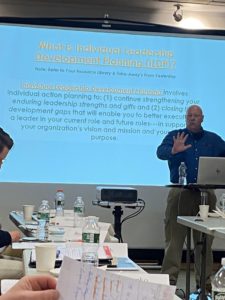Reducing employee turnover-5 simple actions
5 Ways to Reduce Turnover, and Solve Big Problems
Today’s executive leadership is acutely affected by the strain and stress of managing employee retention and turnover. Recently, the U.S. Census Bureau reported on record numbers of employees who quit their jobs in 2021 – a total of 69 million Americans left the workforce. Research has long shown that employees don’t quit bad jobs, they quit bad bosses. Here’s what today’s leadership can do about it.

Through decades of successfully developing exceptional leaders, ILEC has identified four “game-changing” transformative mindsets that leaders can leverage in business and life: altruism, affiliation, achievement, and abundance (The 4 A’s). The 4 A’s are foundational for realizing sustained greatness, and breakthrough results for themselves and their team. These are the actions and attitudes that build legacies that last. Below, we review a meaningful strategy by looking at the 4 A’s and a special point of advice; five ways to reduce turnover and get an outside perspective to solve employee retention problems along the way.
- Altruism: This is behavior, demeanor, attitude, and example – a belief, clearly and consistently demonstrated, that a company’s leadership is selfless in nature, interested and invested in the well-being of those in their workforce. If altruism isn’t part of your company culture, you aren’t providing your employees with a basic need. Many will go elsewhere to fill their needs.
- Affiliation: For CEOs and other C-suiters, affiliation implies a close association between leadership and workforce that expresses a relatability and connectedness to each other. Can your company claim a close and mutually beneficial relationship through all levels of the organization ? Employees who feel valued are employees who feel content. Content employees produce and perform and stick around.
- Achievement: In high functioning organizations, achievement is both a stated goal and occasion to celebrate – especially together. Are your employees engaged? Do they feel seen, heard, and valued? Do they understand what’s expected of them and how to succeed? As a leader, if you can’t define achievement, or celebrate it when it occurs, your employees won’t feel connected to the organization as a whole and morale will undoubtedly suffer.
- Abundance: Abundance means there’s a mutual feeling of confidence and fulfillment among your organization. Are you broadening the vision of what’s possible? Are your company’s interests aligned with the achievement of your workforce, or are they at cross purposes? As an executive leader, is there enough of your leadership to go around? If not, what areas of the business (and your personal life) are suffering because of it? People need to feel recognized, fulfilled, and that there is abundancy. Those who feel this way rarely need to see how much greener the grass is on the other side of the fence.
- Hire an Experienced Executive Coach: The ongoing struggle to recruit and retain the most talented staff members is real, and the damage done from employee turnover can result in incalculable losses for companies and organizations. For some, it requires outside assistance. Look for a coach who is well-skilled at assessing company culture and putting actionable steps in place to address high turnover and low employee engagement.
Working with an executive leadership coach can pay big dividends, both short and long term. The value of retaining your top talent is too great to gloss over. Overcoming this challenge requires a real commitment and well-designed solution. Engaging with an effective coach is a cost-effective solution that can save you from experiencing big-time problems or help deliver you if you are already in the midst of them.
Intelligent Leadership Executive Coaching (ILEC) is the world’s No. 1 executive coaching platform dedicated to growing tomorrow’s leaders through organizational transformation. Master certified ILEC coach Ted Turner utilize a proven blueprint and philosophy designed to help you become an effective executive leader. If you’re ready to take the all-important first step, let’s discuss your personal mission, vision, and purpose.


